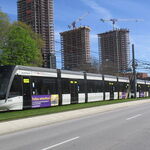steveintoronto
Superstar
Two faulty assumptions:The challenge is that the most trains on the Toronto-Ottawa route will have hundreds of kilometres between stations, which means that trains will mostly need to meet between stations. And these sidings would need to be extremely long in order to achieve the ambitious average speed claims.
1) The number of passing loops and/or stations. There will be many more stations than what you indicate, whether certain trains stop at each is a variance. Most if not all will encompass both passing and stopping loops. And posters such as Urban Sky have pointed out many times the 'insertion loss' (the term used in my field of engineering) for intermediary stops is in the region of five minutes.(That's both the actual platform stop time and deceleration and acceleration back to speed included. I leave it to him to detail further)
2) You completely overlook modern communication systems. Like the latest variances of CBTC, both track transponder and radio based. They not only signal trains and control switches, they *determine the speed and the dynamics of that speed* on the trains. (This includes TASS *) In a sense, other than actual human flesh on controllers, these will be robotic. Also keep in mind that *sizable segments* will run at well above the present 110 mph for non-grade separated sections. One of the advantages of using such a 'lowly populated route' is the ease in which to grade separate the line, and being electric traction, the ramp grades for bridges can be far greater than for freight, for which run-arounds at grade can be built, as the San Diego Trolley does combining the passenger flyovers with the night time (temporally separated) freight operations, done, btw, by an independent freight operator.
Acceleration and deceleration rates for the loops and approaches can be multiples now possible with the present diesel sets.
How that is accomplished is detailed in reports quoted and linked in this string. This isn't rocket science...the Germans and Japanese, just to name a few, have been doing this for generations.
* TASS:
http://ieeexplore.ieee.org/document/1662123/Abstract:
In September 2004, Britain's Virgin Trains introduced radical new timetables for their West Coast and Cross Country services, with more frequent services and significantly reduced journey times. This was made possible by the use of 200km/h tilting operation by Virgin's fleets of electric and diesel trains. To mitigate the additional risks that these tilting trains potentially introduced to the rail network, continuous speed supervision and safe switch on/off of tilt was provided by the TASS (Tilt Authorisation and Speed Supervision) system. TASS was developed by ALSTOM Transport as part of its Virgin Pendolino train contract, with onboard equipment also supplied for the Bombardier Super Voyager diesel trains. TASS uses ERTMS based on-board equipment to carry out the required functions according to telegrams received from passive Eurobalises on the track. The 194 sets of on-board equipment and the 750 Eurobalises now installed are enabling around 420,000 km/week of tilting operation, giving very rapid experience of the performance of ERTMS equipment in full commercial service. [...]
Tilt Authorisation and Speed Supervision
See:From Wikipedia, the free encyclopedia
The Tilt Authorisation and Speed Supervision System, abbreviated as TASS, is an overlay to train protection systems allowing the control the speeds of tilting trains. It is only installed on the West Coast Main Line (UK). Its trainborne part is fitted to British Rail Class 221 and British Rail Class 390.
History
The history of TASS is connected to the privatization program of the West Coast Main Line which was won by Virgin Trains in 1996. The modernisation plan unveiled by Virgin included ambitious targets to increase the line speed from 110 mph (177 km/h) to 140 mph (225 km/h). This would include the use of tilting trains on the existing tracks.
The tilting train tender was won by Alstom with their Pendolino technology. In the first batch 53 trains were ordered which were delivered between 2001 and 2004 to be introduced as British Rail Class 390. With just three years from the specification to the test trains in August 2000 the British class did not differ heavily from the other Pendolino systems.[1] They had been provided to areas with very different train protection systems before and there was a requirement to include features of the European Rail Traffic Management System at the time.
The system is based on Eurobalises to transmit an additional set of speed restrictions on top of the Automatic Warning System (AWS) or Train Protection & Warning System (TPWS). TASS allows a maximum of 25 mph (40 km/h) extra speed on sections with enough clearance for the tilting trains.[2]
See also
- Geschwindigkeitsüberwachung Neigetechnik (GNT) - tilting control based on Eurobalises for some lines in Germany
https://issuu.com/railmedia/docs/tre-september-13/48
http://www.railmagazine.com/trains/built-to-tilt
Lots more on-line.
Last edited:






